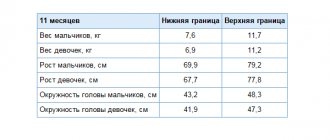The importance of crawling
If a child crawls on his belly, this has a positive effect on his further development. Motor skills are actively strengthened and brain activity is stimulated. Moreover, with the help of such movements, the body's endurance is trained, as well as qualities such as determination and perseverance.
Parents need to take an active part in developing this skill. When the baby has completely mastered this stage, he should move on to crawling on all fours, which will prepare his muscles for further development of standing and walking.
When does a baby start crawling on its belly?
Very often, parents want their baby to learn new skills as soon as possible. First, it is necessary for the baby to learn to roll over. And parents are already looking forward to the moment when the child begins to crawl, and then takes his first small steps. There is nothing wrong with such a desire, but should you be proud if a child begins to confidently stand on his feet at 9 months?
The fact is that now more and more pediatricians are of the opinion that missing the crawling stage can negatively affect the further development of the child. The problem can especially develop in the spine area, since for a fragile musculoskeletal system, early standing on legs represents a serious load, which is necessary for the child in small quantities until the baby’s back is completely strengthened.
That's why it's so important for your baby to learn to crawl first. When mastering and using this skill, the muscles of the arms, back, legs and shoulder joints are strengthened and trained. And only after excellent performance of all the necessary indicators can the child safely stand on his feet and keep his spine in an upright position.
Norms
At what time does a child begin to crawl on his belly? To answer this question in detail, it is necessary to consider all the stages of development that need to go through before a child masters this skill.
- When a baby is about 3 months old, he begins to actively roll over. Mastering this skill leads to the child’s horizons expanding. He can look at many interesting objects around him. In addition, the baby tries with all his might to reach the toy that interests him.
- Since every child is individual, many begin to crawl as early as 5 months. Although the norm is considered to be 6 months. With proper development, by 9 months the baby begins to sit up independently and maintain balance in this position.
- It should be noted that if the child is large, he may not crawl for up to 8 months. In this case, the baby should be shown to a specialist, who will most likely prescribe a massage course.
The age at which babies begin to crawl
Three months after birth, the child acquires the skills of turning over, his range of vision increases significantly, and many interesting objects that are not visible when lying on his back become visually available to him. After some time, he tries to reach out to toys of interest, and a little later crawls to him on his stomach. At the age of 6 months, the parents of the toddler are faced with the question of when the child begins to crawl on all fours. The age at which children begin to crawl varies from person to person. It is believed that this is a period of 5 to 9 months. After six months, the back muscles, arms and legs are already strong enough and the child will try to sit up on his own or has already managed to master this skill. If the baby fits the description of a “hero,” then he may not try to crawl until 8-9 months. In this case, a pediatrician or neurologist recommends undergoing a course of strengthening massage, which will help stimulate the back muscles. Crawling is one of the stages of a baby’s development and should only be done on all fours. This helps the baby develop future walking skills.
We stimulate the development of a skill
Lay a soft, warm blanket on the floor. Place your baby tummy down on it.
If the baby is already trying to master the skill of crawling, then move away from him at a distance of 2 meters. If you can’t crawl yet, then the distance is 1 meter.
Take a bright toy in your hand. It is desirable that it be new. Since the baby will see it for the first time, this will become an undeniable incentive to touch it.
In order for a child to concentrate his attention on an object, it is necessary to move it or make a sound. Sometimes, in order for a baby to notice a toy, it is necessary to show it in front of his face and then move it away.
Seeing a colorful object, the baby will certainly begin to make attempts to get closer to the toy. If a child is trying his best to crawl, but he can’t, then he needs help. To do this, place your palm under the baby’s feet, and he will begin to push off from them on his own.
When the child is at the target, you need to move the toy even further. Repeat this action 2-3 times, and then please your baby at the finish line with a bright toy. To develop this skill, you should not use toys that can roll on the floor (balls, cars, etc.). The child should feel his reward when he achieves the goal. And if she continues to move away from him, this will negatively affect the next lesson aimed at mastering the skill of crawling.
How to help your baby start crawling
The main task of loving parents is to help and not interfere. All they can do is secure the nursery space, stimulate the baby and perform simple exercises with him.
Application of exercises
When the baby rolls over well and briefly rises on his forearms, you can do exercises with him that will help him move independently on all fours in the future:
- Fitball . Such exercises will help strengthen the back muscles and relieve colic if it has not yet completely gone away. The child is placed with his stomach on the ball and held in the armpit area. When the ball rolls slightly, the baby's back tenses, he arches and straightens it, tensing the necessary muscles. Here you will find the entire list of fitball exercises.
- Hand development . These exercises will strengthen both your back and arms. When the baby lies on his back, the mother spreads them apart, then crosses them on her chest. Another good way is for the baby to grab his mother’s thumbs, and she smoothly lifts his arms up and then lowers them down.
- Revolutions . When a baby has a hard time learning to roll over, you can help him with a simple exercise. To do this, mommy puts her thumb in her palm and holds it tightly by the hand. Directing the child's body to turn over, she supports his leg, helping him turn his butt over - read about revolutions.
- Frog . This exercise is useful for children from birth as a prevention of dysplasia. Spread the legs in different directions in a circular motion. It doesn’t hurt to place your hand under the baby’s legs when he is lying on his stomach, giving him the opportunity to push off - gymnastic exercises for the little ones.
Children love these activities very much. The main thing is not to turn the process into a tedious chore, but to do it with positive emotions and a good mood.
If the doctor has prescribed a healing massage when the baby’s muscles are toned or for other indications, it is better to contact a knowledgeable massage therapist. But in order for the baby to quickly begin to move on all fours, parents can perform a restorative massage at home.
It is important not to overdo it and follow some rules:
- massage is done no earlier than half an hour after feeding;
- Mommy will need to remove all rings and bracelets so as not to injure the baby’s delicate skin;
- the procedure time should not exceed 10 minutes;
- It’s good if the child’s favorite songs, jokes or rhymes are played at this time. He needs to hear his mother's voice and feel comfortable.
The massage consists of stroking the arms from the outside and inside from the hands to the forearms, the legs are massaged from the feet to the pelvis, without touching the knee joints . The back is stroked up and down.
It will be useful: what to do if a baby’s eyes fester - how to treat and what to rinse with?
Provocation to action
So that the baby can start crawling faster, he needs space. Children's stores sell a huge variety of colorful rugs that encourage crawling. A child can spend a lot of time on them as early as five months. If you were unable to purchase one, there is no need to be upset. You can lay a regular blanket on the floor and put several different toys. Having lowered the baby to the floor, you need to lie next to him and move the toys a little away. There is no need to place objects too far away, the main thing is that after a few efforts he can reach them.
If the child is not doing well, he moves on his belly; you can put a hand under his legs or position him so that he pushes off the wall. Mommy can also crawl next to the baby, setting a good example. It is advisable to praise and approve the child’s actions. At this age, he does not yet understand words, but he feels intonation and adopts the mood of his parents. Children who have learned to crawl quickly love various barriers, manholes, and tunnels under chairs. Stores sell obstacle courses, but you can make your own using stuffed animals, folded towels or blankets.
The floor where the baby will crawl should be clean and relatively safe. It is recommended to remove lampshades, lamps, small objects, and hanging iron cords from the ironing board. Parents whose apartment has a cold floor should not use this excuse to prevent their baby from crawling. It is enough to wear a jacket and insulated rompers. By moving, it will not freeze, but on the contrary, it will strengthen the body.
How to teach a child to crawl. The most useful!
A good example
What time does a child crawl on his belly?! As described above, children begin to master this skill by 5–6 months. Parents are able to help the baby, and in addition to toys, they can show the crawling process by example.
During the first attempts of the child, you can accompany him nearby. Crawling together between parents and baby not only makes the process more fun, but also serves as a role model for the baby. And praise and encouragement from adults only stimulate the baby to make greater efforts.
As soon as you notice that the baby is making progress, you need to complicate the task by creating small obstacles in the child’s path. These could be small passages under chairs, barriers in the form of towels rolled into rolls, etc.
Stages of crawling
When a child begins to crawl on his belly, this means that he will soon move to all fours. The way it works is that most babies initially start crawling on their tummy. Some move forward, while others move backward. Why the backward movement occurs is still unknown. But after that, some of them begin to master moving to the sides, while the rest crawl on their bellies.
Some babies begin to master the skill of crawling on their tummy, while others immediately go to all fours. But there are children who use both options for moving.
Crawling on all fours looks like this from the side: the baby places two arms on the floor in front of him, and then pulls his legs in with a light jump. Other stages of crawling are based on rocking forward, while the baby stands on his arms and legs. When performing this action, the baby places his arms one by one, and then moves his legs towards them.
And, perhaps, the most developed stage of crawling is the cross movement. It is believed that to perform such an action requires serious work of the central nervous system. Such crawling is a simultaneous movement of the right upper limb along with the left lower one, and then changing them in the right direction. Mastering this stage is a high achievement in the ability to crawl.
Approximate age for a baby to start crawling
The age range for crawling that doctors focus on is 5-9 months. On average, children at 7-8 months are already moving quickly and confidently around the apartment.
If a child does not begin to crawl at the full 9 months, you should see a doctor to check his musculoskeletal system.
Each baby develops individually. It all depends on the state of health, genotype, physical characteristics, in which psycho-emotional circle he is located. It is impossible to say exactly what time a child will start crawling on all fours. But if the baby is active, quickly learned to roll over onto his tummy, and strives to move independently, then he will probably soon begin to crawl. Sitting, crawling, walking - steps that the baby overcomes if the desire arises. Parents should not push him, load him or force him, but it is necessary to ensure hardening, prevention of rickets and muscle development.
Helpful: a baby develops a cough without a runny nose or fever - what could be the problem?
Why is the crawling stage important?
Modern pediatricians consider skipping the crawling stage to be extremely undesirable. The person will lead an upright lifestyle for the rest of his life. The infant's fragile muscular and skeletal system is not yet ready for stress. During crawling, the back muscles are developed and developed to support the spine normally and correctly. In addition, while crawling, the baby develops thinking, because alternating arms and legs is complex brain work. A new world opens up for the baby with objects that he could not see while lying on his back or stomach.
Interesting fact! In Japan, an experiment was conducted in which half a class of elementary school children walked on all fours during breaks, while the other led a normal lifestyle. A month later, the performance of the upright children was far behind that of the crawling children. When the spine is unloaded, mental capacity increases. The longer a child crawls, the better for his development.
What stages of crawling are distinguished?
The crawling process is conventionally divided into stages, but this does not mean that the child will go through all of them. It happens that the baby begins to crawl immediately, throwing out his arms, and it happens that he tries to master tactics on his belly, gradually moving on to more complex steps.
Main stages:
- On your belly, lying on your stomach. The very first stage that parents do not immediately notice. The baby can spin on his stomach while moving forward. But it turns out that he is crawling sideways or moving backwards. Leaving him on the sofa without fences and supervision is highly not recommended. Puffing and puffing, he can quietly crawl to the edge and fall.
- Handles are used. Some children, using one bent arm, pull up their body, others put both arms out and then bend their legs. The movements are reminiscent of the clumsy jumping of a frog, but with the help of such crawling, the baby is already able to reach the toy that interests him, if it is close. During breaks, he can get tired, rest and rush into battle again.
- Cross. After some time, coordination of movements improves so much that the child switches to the cross method of crawling. Clearly alternating the movements of his arms and legs, he quickly begins to move around the room, faster each time. This method of movement strengthens the back, develops motor skills, shapes speech and the thought process. At the same time, character traits are developed - endurance, determination, willpower.
Why do children crawl on their bellies?
Most babies begin to move in space, moving on their bellies. Some experts consider this stage in the development of crawling to be very useful for the development of the baby. Moreover, in the process of research it was proven that children who were careful and began to crawl, pressing themselves to the floor, before mastering the position on all fours, were more inclined to the exact sciences and think much better logically.
Some children tend to be very cautious, so they are afraid to lift their body from the floor, as they are afraid of falling.
How to help?
If a child has been crawling on his belly for a long time, perhaps parents should help him overcome his fear of getting on all fours. To do this, you need a terry towel, which you need to pass under the baby, holding its ends with your hands. Then use this device to place the baby on all fours. This way you will complete several tasks:
- You will take on part of the baby's weight.
- Insure him when he falls.
- Help him overcome his fear of heights for the first time in his life.
After several such repetitions, the baby will get the hang of it and begin crawling on all fours. It happens that prolonged crawling on the belly is caused by weakness of the baby’s limb muscles. In this case, massage and gymnastics will help solve the problem.
If a child at 7,8,9 months crawls on his belly.
In general, from 7 months it’s time for the baby to master all fours, i.e. By this time he should already be crawling away on his stomach for about 2 months. The physical capabilities of infants at this age are not at the same level for everyone, but for this there is massage and gymnastics. If a child has a delay in motor development, then it is advisable for a massage therapist to work with him, it is better, of course, if it is on time, i.e. a course of massage with gymnastics at 3 and 6 months, then most likely there will be no delays.
We remember that for babies with “aggravating circumstances” such as prematurity, illness, surgery, etc., we need to make allowances and not overload them with all kinds of developmental items.
The child may be lazy and not want to put too much strain on himself, especially if his mother gives him everything and takes him in her arms at the first peep. But practice shows that after a course of strengthening gymnastics, even overly calm children become more active, new skills appear, in a word, progress in development. Therefore, if a child at 7,8,9 months is still crawling on his belly, then take measures to strengthen the baby, it’s time for him to crawl on all fours.
Doctors' recommendations
- If a child at 9 months crawls on his belly, measures should be taken to teach the baby to stand on all fours.
- Try to keep playpen use to a minimum. The baby needs free space to practice crawling.
- Play with your baby regularly. It is enough to do this several times during the day for the baby to learn something new.
- Welcome any attempts to master the skill of crawling.
- If your baby is not crawling on all fours by the age of 10 months, you should consult a specialist.
Modern pediatricians believe that a child should not skip the crawling stage. The fact is that walking, which the baby will master in the future, puts a strong load on the spine. Namely, when crawling, the back muscles are actively strengthened, which have a direct effect on supporting the spine in an upright position.
If your baby doesn't want to get up...
- If by 10 months the child has not gotten on all fours, help him with exercises on the muscular corset of the legs: jumping, lifting, resting, which are performed several times daily.
- If he once fell, even from a small height, the child can “record” this negative experience on the subcortex and then be afraid to get back on his feet. Therefore, the parent is simply obliged to help in overcoming fear: for this you will need a sheet folded in four, which is passed under the baby’s tummy and the ends are tied above it. Then, seeing that he has crawled on his belly, you need to pull the knot up a little, while the weight will decrease and the child will feel supported. If the experiment is successful, your child will begin to crawl on all fours.
- Children who are often sick crawl on their tummy for a long time, since their body is slightly behind in mastering motor skills due to taking medications, and they are characterized by muscle weakness. In order for the baby to grow fully and stand on his feet for up to a year, you need to gradually lay him out on his tummy from the very first day, massage his feet, hands, and do morning exercises every day.
- A small roller with any natural filling is placed under the baby’s tummy when he crawls like a guerrilla. At the same time, he will try to take a comfortable position, first he will begin to rest on his hands and stand in this position, and then he will kneel. In order for the pose to be fixed, you need to attract attention with your hand with a toy, to which you need to crawl (the roller must be removed).
- Be attentive to your baby, listen to his conditions, think about how to help him develop, but not harm him.











